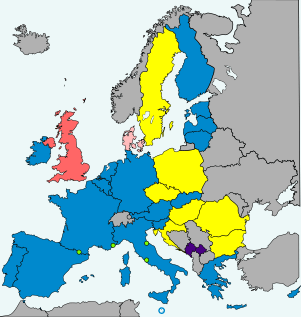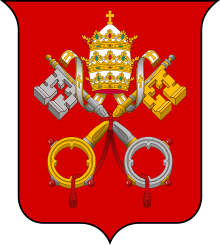Vatican euro coins

- European Union (EU) member states
- Non-EU member states
Vatican euro coins are issued by the Philatelic and Numismatic Office of the Vatican City State and minted by Istituto Poligrafico e Zecca dello Stato (IPZS), in Rome, Italy. The euro is the official currency of the Vatican City, although the Vatican is not a member of the Eurozone or the European Union.
Vatican euro design
For images of the common side and a detailed description of the coins, see euro coins.
First series (2002–2005)
The initial series of Vatican euro coins featured an effigy of Pope John Paul II. They were issued only in collector sets and bore an extreme markup with the 2002 collector set costing well over a thousand euro.[1]
| € 0.01 | € 0.02 | € 0.05 |
|---|---|---|
| Effigy of John Paul II. | ||
| € 0.10 | € 0.20 | € 0.50 |
| Effigy of John Paul II. | ||
| € 1.00 | € 2.00 | € 2 Coin Edge |
| Effigy of John Paul II. | ||
Second series (2005)
Following the death of Pope John Paul II in April 2005, the Vatican issued special coins during the period of Sede vacante depicting the emblem of the Apostolic Chamber (i.e. two crossed keys beneath an umbraculum, or umbrella) and the coat of arms of the Camerlengo of the Holy Roman Church, at the time Cardinal Eduardo Martínez Somalo.[2]
| € 0.01 | € 0.02 | € 0.05 |
|---|---|---|
| Insignia of the Apostolic Chamber and the coat of arms of the Camerlengo of the Holy Roman Church | ||
| € 0.10 | € 0.20 | € 0.50 |
| Insignia of the Apostolic Chamber and the coat of arms of the Cardinal Chamberlain | ||
| € 1.00 | € 2.00 | € 2 Coin Edge |
| Insignia of the Apostolic Chamber and the coat of arms of the Cardinal Chamberlain | ||
Third series (2006–2013)
When the new pope was elected, the third series of Vatican euro coins were issued on 27 April 2006 and feature the effigy of Pope Benedict XVI. The coins carry an inscription "Città del Vaticano" and the twelve stars of Europe. The details of this design are published in the Official Journal of the European Union.[3]
| € 0.01 | € 0.02 | € 0.05 |
|---|---|---|
| Effigy of Benedict XVI. | ||
| € 0.10 | € 0.20 | € 0.50 |
| Effigy of Benedict XVI. | ||
| € 1.00 | € 2.00 | € 2 Coin Edge |
| Effigy of Benedict XVI. | ||
Fourth series (2014–2016)
A series of Vatican euro coins featuring effigies of Pope Francis was released in March 2014.[4] Three different images of Francis were used.[5]
| € 0.01 | € 0.02 | € 0.05 |
|---|---|---|
| Effigy of Francis (left profile). | ||
| € 0.10 | € 0.20 | € 0.50 |
| Effigy of Francis (front profile). | ||
| € 1.00 | € 2.00 | € 2 Coin Edge |
| Effigy of Francis (right profile). | ||
Fifth series (2017–present)
A series of Vatican euro coins featuring the coat of arms of Pope Francis was issued from 2017 onwards.[6] Starting March 2017, the eight denominations of Vatican euro coins no longer bore the Pope's image and now feature the papal coat of arms of Pope Francis.[6]
| € 0.01 | € 0.02 | € 0.05 |
|---|---|---|
| Coat of arms of Pope Francis and European Union stars | ||
| € 0.10 | € 0.20 | € 0.50 |
| Coat of arms of Pope Francis and European Union stars | ||
| € 1.00 | € 2.00 | € 2 Coin Edge |
| Coat of arms of Pope Francis and European Union stars | ||
Circulating Mintage quantities
| Face Value [7] | €0.01 | €0.02 | €0.05 | €0.10 | €0.20 | €0.50 | €1.00 | €2.00 |
|---|---|---|---|---|---|---|---|---|
| 2002 | 6,000 | 6,000 | 6,000 | 6,000 | 6,000 | 6,000 | 6,000 | 6,000 |
| 2003 | * | * | * | * | * | * | * | * |
| 2004 | * | * | * | * | * | * | * | * |
| 2005 | * | * | * | * | * | * | * | * |
| 2005 SV | * | * | * | * | * | * | * | * |
| 2006 | * | * | * | * | * | * | * | * |
| 2007 | * | * | * | * | * | * | * | * |
| 2008 | 6,400 | 6,400 | 6,400 | 6,400 | 6,400 | 6,400 | 6,400 | 6,400 |
| 2009 | 6,400 | 6,400 | 6,400 | 6,400 | 6,400 | 6,400 | 6,400 | 6,400 |
| 2010 | 6,000 | 6,000 | 6,000 | 6,000 | 6,000 | 2,190,704 | 6,000 | 6,000 |
| 2011 | 6,000 | 6,000 | 6,000 | 6,000 | 6,000 | 2,174,197 | 6,000 | 6,000 |
| 2012 | 6,000 | 6,000 | 6,000 | 6,000 | 6,000 | 1,604,690 | 6,000 | 6,000 |
|
* Small quantities minted for sets only | ||||||||
Future changes to national sides
The Commission of the European Communities issued a recommendation on 19 December 2008, a common guideline for the national sides and the issuance of euro coins intended for circulation. One section of this recommendation stipulates that:
- Article 5. Changes to the national sides of regular euro coins intended for circulation:
- "... the designs used for the national sides of the euro coins intended for circulation denominated in euro or in cent should not be modified, except in cases where the Head of State referred to on a coin changes ... A temporary vacancy or the provisional occupation of the function of Head of State should not give the right to change the national sides of the regular euro coins intended for circulation."
This change means that there will be no more "Sede Vacante" series of the regular Vatican euro coins, although the issue of commemorative "Sede Vacante" series (usually gold and silver coins), having legal tender in Vatican City only, remains possible. Circulating €2 commemorative Sede Vacante coins would also be possible, if the Sede Vacante period occurs in a year in which the Vatican has not already released a €2 commemorative of another subject.
€2 commemorative coins
- 75th anniversary of the Foundation of the Vatican City State (2004)
- 20th World Youth Day in Cologne (2005)
- 500th anniversary of the Swiss Pontifical Guard (2006)
- 80th anniversary of the birth of Benedict XVI (2007)
- Year of the Apostile (2008)
- International Year of Astronomy (2009)
- Year of the Priests (2010)
- XXVI World Youth Day in Madrid (2011)
- 7th World Meeting of the Families (2012)
- XXVIII World Youth Day in Rio de Janeiro (2013)
- Sede vacante (2013)
- 25 years since the fall of the Berlin Wall (2014)
- 8th Meeting of the Families (2015)
- Jubilee of Mercy (2016)
- Bicentenary of the Vatican Gendarmerie (2016)
- Centenary of the Fatima Apparitions (2017)
- 1950th Anniversary of the Martyrdom of Saint Peter & Saint Paul (2017)
In addition, in 2014 the Vatican issued commemorative €20 and €50 coins honoring Pope John XXIII and Pope John Paul II respectively.[5] Both popes were canonized in April 2014.[8]
See also
Notes
- ↑ Kosovo is the subject of a territorial dispute between the Republic of Kosovo and the Republic of Serbia. The Republic of Kosovo unilaterally declared independence on 17 February 2008, but Serbia continues to claim it as part of its own sovereign territory. The two governments began to normalise relations in 2013, as part of the Brussels Agreement. Kosovo has received formal recognition as an independent state from 113 out of 193 United Nations member states.
References
- ↑ Vatican Euro Coins
- ↑ The description of the new national side can be found in the Official Journal of the European Union C308/17 (6/12/05) (PDF)
- ↑ Official Journal of the European Union: New National Faces Of Euro Coins Intended For Circulation - Vatican City, C 186/2, Retrieved on 2006-11-29
- ↑ "Vatican Issues Euro Coins Featuring Pope Francis". KMBZ, 4 March 2014. (accessed 10 March 2014)
- 1 2 PONTIFICATE OF POPE FRANCIS - EURO COINS PROOF VERSION - YEAR 2014. Vatican City State. (accessed 10 March 2014)
- 1 2 http://www.coinworld.com/news/world-coins/2017/02/vatican-city-adopts-new-euro-coins-in-2017.all.html
- ↑ "Circulating Mintage quantities". Henning Agt. Retrieved 2008-08-19.
- ↑ "Popes John Paul II, John XXIII to be declared saints in April", World News, Fox, Sep 30, 2013 .
External links
- Vatican Philatelic and Numismatic Office
- The Euro Information Website – Vatican – Series 1 *Series 2 Series 3
- European Commission Vatican euro coins
- European Commission Commemorative Vatican euro coins
